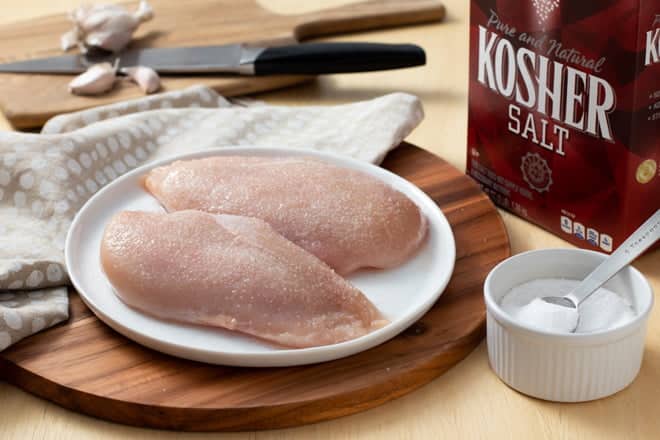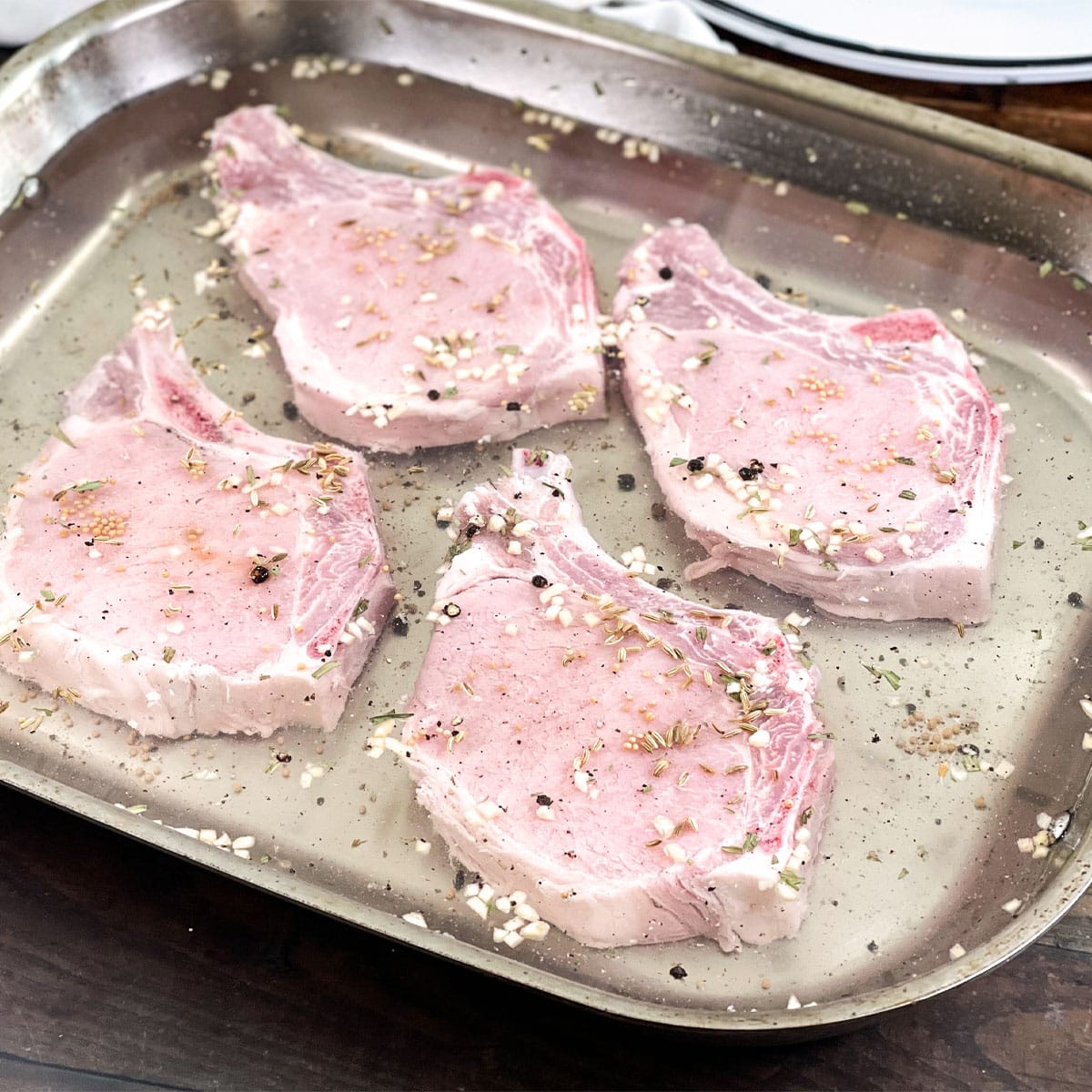I tested different times and types of salt to find the best method for dry-brining steaks. You’ll get juicy, tender, flavorful steaks every time.
Dry-brining is the technique of salting meat directly, without using water, and letting it rest with the salt on for awhile. This is supposed to work especially well for steaks, giving them flavorful seasoning deep into their centers, tenderizing the meat, and also helping to dry the exterior for a superior crust. I decided to test dry-brining some steaks to find the best amount of salt to use, and the amount of time needed for the dry brine to work best.
Read my results about the best way to dry-brine steaks below or click here to head straight to the instructions.

Over the years, I’ve become a bit of a brining expert, doing extensive testing on both wet brines and dry brines on various cuts of meat to find the perfect methods and timings. I’ve perfected my chicken breast brine and learned all about brining pork chops. I’ve even found a favorite way to the most flavorful, best turkey brine recipe. So clearly, the next step was to take all this knowledge and apply it to steaks.
Why Not A Wet Brine For Steak?
Dry brines for steaks are definitely easier than a classic wet brine. They’re actually better for steaks though too. The reason is that the kinds of beef that we cook as steaks are already tender. We therefore don’t need to add much moisture to them, and in fact, the extra moisture will dilute their robust meaty flavor. A dry brine, on the other hand, serves to season the meat and tenderize it a bit, without adding liquid. The dry brine also helps to dry the outside of the meat so that it can have a better crust when you cook it.
How Long To Dry-Brine Steak?
The amount of time for brining a steak depends greatly on how thick the steak is. I used a standard New York Strip steak about ½ to ¾-inches thick in testing this recipe, with a simple, dry brine containing salt and a little granulated garlic.
As Kenji from Serious Eats explained, a strip steak that has been salted and allowed to rest for as little as 45 minutes will be well seasoned and tender, so I wondered what would happen if the dry brine was left on for two hours, four hours, eight hours, and 16 hours, and if these different times would impact the steak’s flavor and tenderness.

You can see from the photograph above that the two and four-hour dry brines only penetrated about 1/8th deep into the steak, indicated by the slightly darker color around the edges. When I cooked and tasted these two, they were well seasoned, but the texture was a little mushy on the surface. This is because I didn’t give the salt enough time to fully absorb back into the steak.
The eight-hour and 16-hour, however, were well seasoned and tender, and the steak texture was exactly how it should be. These weren’t mushy at all. There wasn’t really much difference between the 8-hour and 16-hour steaks, so for time’s sake, I made the eight-hour my standard.
Best Salt To Use For Dry-Brining
It should be noted that may resources claim that kosher salt is the best for dry-brining. However, the reasons given for why aren’t great. For instance, Serious Eats notes that it’s because kosher salt is easier to sprinkle more evenly and doesn’t clump up. I found it easy to sprinkle table salt evenly with no clumping, so that isn’t an issue.
Some chefs and recipe developers dislike iodized table salt for its chemical flavor. You can, however, purchase non-iodized table salt, so if that is an issue for you, it’s not really an argument against table salt here.
If anything, I thought that table salt might be better for dry-brining because it’s finer so you can achieve a very even, thin, layer of salt on the surface of the meat. But I wanted to test it to see for sure if it made any difference. I wanted to find out whether kosher salt and table salt have a different effect on the tenderness and flavor of the steak.
Note that for the timing tests above, I used basic table salt. The reason for choosing this was because I wanted to have results that the average home cook can achieve without purchasing special ingredients. Then, once the timing tests were complete, I followed up by testing two types of salt: kosher salt compared to table salt. I did the comparison using our optimum time of 8 hours.

For the top steak in the above picture, I used 1/4 teaspoon of table salt per side of the steak. For the bottom steak, I used a very slightly rounded 1/4 teaspoon of kosher salt. The rounding was done to control for the larger size of kosher salt crystals which result in less sodium per volume.
And now, here you can see them after 4 hours in the fridge. At this point, there is no difference in appearance and the salt seems to have soaked in evenly to both steaks.

I cooked the two steaks side by side and did a taste test myself. I also had a very willing participant do a blind taste test.
Neither of us found any discernable difference between the steak dry-brined with table salt versus kosher salt. I therefore conclude that it doesn’t matter what kind of salt you use when dry-brining. If you have a preferred kind of salt, use that, and get a nice and thin, even layer of the salt per side of steak, using about 1/4 teaspoon per side.
How To Dry-Brine Steak
To dry-brine a steak, begin by placing it on a wire rack fitted into a sheet pan. Then, in a small bowl stir together the salt and optional granulated garlic. Remember, the salt will penetrate into the meat, while the garlic stays mostly on the surface. The steaks will still have a subtle garlicky flavor, but if you’re looking for a big punch of garlic, it’s best to add it at the end of the cooking process or to a sauce.
Sprinkle the mixture evenly onto both sides of the steak and then rub the mixture in.
Place the sheet pan with the steak into the refrigerator for eight hours, uncovered. Before cooking, remove the steak from the refrigerator and allow them to come to room temperature. This will help them cook more evenly no matter which recipe you follow.
Why Do I Need A Rack To Dry-Brine?
We use a wire rack on top of a sheet pan for dry-brining. This keeps the steaks dry by allowing the air to circulate all around the steaks and allowing any juices to drip away onto the pan. A drier steak is preferred because it will develop a better crust when cooking.
How To Season Brined Steaks Before Cooking
You really don’t need to add anything else to your steaks before cooking. And you definitely don’t want to rinse them or pat them dry. If you’d like, you can add some black pepper before cooking, but additional flavors are best added at the end or after cooking your dry brined steaks.
Cooking Your Steak
You can use whatever your preferred method of cooking steak after you’ve dry-brined. A method that delivers a really amazing steak is a reverse sear, done by cooking it at a low temperature in the oven and then searing it at the end. Or, try this New York Strip Steak recipe if you want to add other flavors to your steak, like butter, herbs, and garlic.

Finish by serving with this amazing compound butter for steaks and your favorite steakhouse side dishes.
Podcast Episode: Dry-Brining Steaks
Listen to me explain briefly about how to make these dry-brined steaks, along with some other great tips, by clicking the play button below:

Recipe: Dry-Brined Steaks
- Prep Time: 8 hours
- Cook Time: 0 minutes
- Total Time: 8 hours
- Yield: 2 servings 1x
- Category: Entrée
- Method: Brine
- Cuisine: American
Ingredients
- 2 (3/4-in. thick) uncooked New York Strip steaks
- 1 tsp. salt
- 1/2 tsp. granulated garlic (optional)
Instructions
- Transfer uncooked steaks to a wire rack fitted into a sheet pan.
- In a small bowl stir together salt and granulated garlic.
- Sprinkle ¼ teaspoon of the salt mixture on one side of each steak, rub into steaks. Flip steaks, repeat with remaining mixture.
- Transfer sheet pan to refrigerator. Let steaks rest uncovered for 8 hours.
- Remove sheet pan from refrigerator. Let steaks come to room temperature before cooking. Do not rinse seasoning off steaks.
- Grill or sear in a hot pan until desired temperature is reached. Note that if you are following a recipe to cook your steak that calls for salt, omit the salt.
Love this recipe? I’d appreciate it if you could scroll down and add a *5 star rating* to help others know they’ll love it as well!


























Can you go into more detail about why one shouldn’t pat dry the steak after dry brining?
I have always read to pat the steak dry before pan searing to get rid of moisture that will affect the formation of the crust?
My usual method has been to pull from the fridge and dry brine 2 hours (for a 2″ thick cut) on the counter, pat dry, sear, rest, finish with butter basting to temp.
Ben, I actually am not sure that it will end up making a huge difference in the end.
My thinking on this is that there is flavored juiciness on the outside of that steak, and nice saltiness, and I don’t want to do anything to take any of that away. If the skillet or grill is really hot, and if you have hot oil involved, the bit of moisture on the steak surface isn’t going to affect things very much. So I opt for not touching it.
Having said that, my family likes their steaks more medium to medium-well, so the steaks are on the hot surface for a good amount of time and definitely get a good sear. If you’re doing yours to rare or medium-rare, everything that you can do to get a good sear is going to be best. Patting dry might be best in that case.
I will say this though about something else you mentioned in your method. If you like your steak medium, medium-rare, or rare, try leaving it in the fridge for the entire dry-brining time, and then searing it right after taking it out of the fridge. The idea is that if the steak is cold inside, it will take longer to reach your desired temperature, and therefore it will have contact with the heat for longer and get a better sear. I learned this from Lynne Rossetto Kasper on The Splendid Table years ago and I swear by it. If you’re interested in experimenting with subtle differences in your method, this would be a good one to try!
Can I sous vide the steak after your brining method?
John, I think that you probably can. In general, you can cook brined meats any of the ways that you normally cook them, except, I sometimes find that wet-brined meats in a stewed or braised environment can give off their salty liquid. But I don’t think that would happen here. My only concern would be that the very very slow cooking in the sous vide temperature could act as additional brining time, leading to a saltier steak. I have a friend who is a sous vide cookbook author and president of the International Sous Vide Association, Jason Logsdon. I’m going to send him an email and verify this for you. I’ll post what he says here, and I’ll email you as well. Thanks for a great question!
What do you think about using hickory salt?
Charles, I haven’t tried hickory salt. However, I have used Maldon Smoked Sea Salt and it was very good. It gave a subtle smoky flavor that I really liked. If the hickory salt is similar, I bet it will be wonderful! If you try it, make sure to come back and let us know how it turned out!
can i dry brine a standing rib using these directions?
Margaret, yes, you absolutely can. :-)
The only difference is that you’ll leave the salt on for longer. I actually have more detailed instructions for how to dry-brine a beef roast over here: https://cookthestory.com/classic-roast-beef/ If you give it a try, come back and let me know what you think.